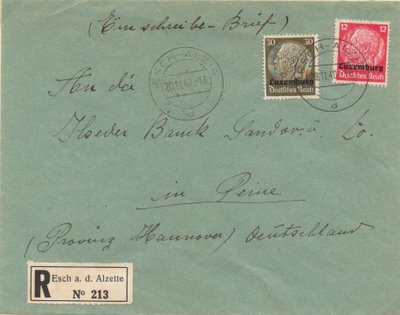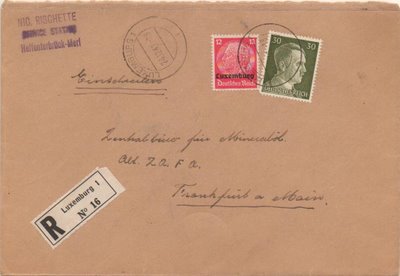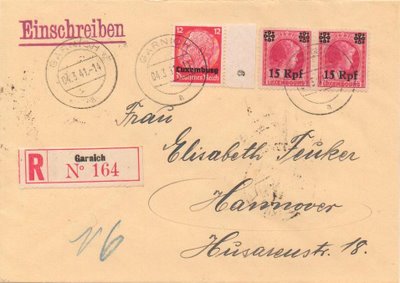During World War II, Luxembourg was overrun by German forces on May 10, 1940, and the country continued to be occupied until September 10, 1944.
The following dates during the WWII Occupation are of especial significance for postal historians:
- On October 1, 1940, the Occupiers abolished the use of the Grand Duchy’s stamps and postal stationery, replacing them with the German Hindenburg stamps and postal stationery denominated in Reichpfennigs and marks and overprinted “Luxemburg.” Luxembourg’s postal rates also were converted into the Reich’s currency.
- On December 5, 1940, certain of the invalidated pre-war Luxembourg stamps and postal stationery were "re-issued" after being surcharged from centimes and francs to pfennings. Their use was permitted used until March 31, 1941 (a 117-day period).
- As of April 1, 1941, all German stamps also became valid for use in Luxembourg.
- As of January 1, 1942, use of German stamps was required and use of the Hindenburg overprints was no longer permitted.
As of October 1, 1940, the charge to send a registered letter weighing 20 g or less within Luxembourg, or to Belgium or the Reich was 42 Reichpfenning (rpf.) (12 rpf. postage plus a 30 rpf. registry fee). However, when this registered letter rate took effect, a 42-rpf. definitive stamp was not available to pay this charge. Since sole frankings therefore were not possible, these registered letters provide an excellent opportunity for collectors to acquire a broad range of interesting mixed frankings.
It should be noted that the Reich finally did issue a 42-rpf. Hitler-head definitive sometime in 1944 [Scott 529], so conceivably sole frankings in 1944 with this stamp paying the 42-rpf. rate exist, although I’ve yet to discover one. Additionally, each year during the Occupation, the Reich issued a 42-rpf. semi-postal stamp with a 108-rpf. surcharge that benefited Hitler’s so-called National Culture Fund. These are known as the “Brown Ribbon” stamps as they were issued during the annual summer Brown Ribbon horse races in Munich [Scott B173, B192, B205, B243 and B283]. Sole frankings with these stamps, if they exist, would likely have been philatelically inspired as these semi-postal stamps (the first two of which were valid only for a short time) were not sold over the postal counters in Luxembourg and the populace generally would have been disinclined during these difficult years to pay a 257% surcharge to benefit the Nazi Culture Fund.
With the foregoing caveats in mind, let’s look at the 42-rpf. frankings that do exist:
The low denomination Hindenburg overprints consist of 5, 6, 10, 12, 15, 20, 25 and 30 rpf. values. Thus, the only two-stamp franking possible with the Hindenburgs was a combination franking of the 12 and 30 rpf. values, as shown below:

Two-stamp Hindenburg franking—Esch-sur-Alzette, November 20, 1940, to Peine, Germany. This is probably the most common 42-rpf. franking as the Hindenburg overprints could be used from October 1, 1940 to January 1, 1942.
From April 1, 1941 until January 1, 1942 (a 275-day period), a similar franking was possible using either a 12 rpf. Hitler-head and a 30-rpf. Hindenburg or a 30-rpf. Hitler-head and a 12- rpf. Hindenburg (shown below):
Two-stamp mixed Hindenburg-Hitler franking—Luxembourg-Ville, December 24, 1941 to Frankfurt, Germany, Christmas Day 1941.
Another possibility with the Hindenburgs was a three-stamp franking using two 6-rpf. Hindenburgs and a 30-rpf. Hindenburg, as shown below:

Three-stamp, two-denomination Hindenburg franking—Esch-sur-Alzette, November 5, 1940 to Berlin, Germany, November 7, 1940. The Nazis had not yet replaced Esch-sur-Alzette’s pre-war bridge cancel, although a new, Germanized registry label was used.
From December 5, 1940 through March 31, 1941, the pre-war Luxembourg stamps that had been surcharged also could be used exclusively or in combination with the Hindenburgs. The low value surcharges included 3, 4, 5, 6, 8 10, 12, 15, 20, 25 and 30 rpf. values. An example of such a combination is shown below:

Three-stamp mixed Luxembourg-surcharge and Hindenburg franking—Garnich, March 4, 1941 to Hannover, Germany, March 5, 1941. The three red stamps, the red registry label, and the red rubber-stamped Einschreiben all together provide a lot of philatelic pulchritude!
Three-stamp Hindenburg frankings also were possible:

Three-stamp, 10, 12, & 20-rpf. Hindenburg franking—Eschdorf, October 16, 1940 to Peine, Germany, October 18, 1940.
Three-stamp, 5, 12, 25-rpf. Hindenburg franking—Luxembourg-Ville, March 31, 1941 to Wilthen (Oberlausitz), Germany, April 4, 1941.
Last, a seven-stamp franking also was possible using just the 6-rpf. Luxembourg surcharge, just the 6-rpf. Hindenburg, or a combination thereof. Use of seven 6-rpf. Luxembourg surcharge stamps is shown below:

Seven-stamp Luxembourg surcharge franking—Lorentzweiler, February 26, 1941, to Hannover, Germany, forwarded to and received in Ensheim, Germany, March 1, 1941.
2 comments:
Sorry to resurrect an old blog but I've been catching up on this for the past year or so.
I recently bought a Luxembourg cover with 3c Hindenburg + 5c GD Charlotte (1926), postmarked Luxembourg-Limpertsberg 02-10-40 3-4M.
You've probably seen many but I have a scan if you'd like to see. Not bad for my sixth Luxembourg cover :-)
I returned to my stamps for, I think, the fourth time in 2013. For some reason I chose Luxembourg. I have learnt more from this blog in 16 months than I could hope to learn over many years. Thanks You for sharing your knowledge on the subject.
Best Regards
John
Hello John,
Very nice to hear from you.
If you like, send me a scan of your cover. I'll take a look. Mixed frankings were permitted only on 1 and 2 October 1940.
You can contact me at: Arsdorf@gmail.com
Let me know if you have questions about Luxembourg philately. I also blog about thge revenue stamps at:
www.luxrevenuephilately.blogspot.com
www.luxcommunalrevenuestamps.blogspot.com
Cordial collecting,
Allan
Post a Comment